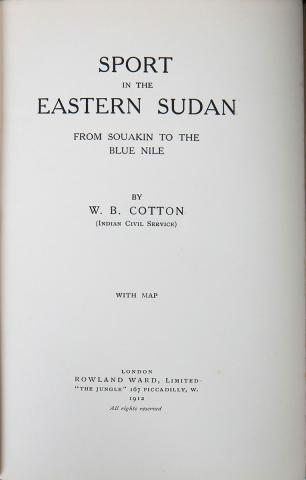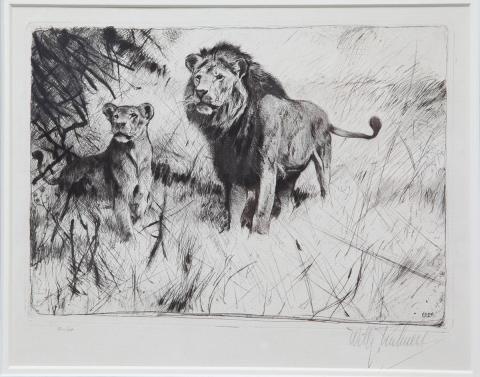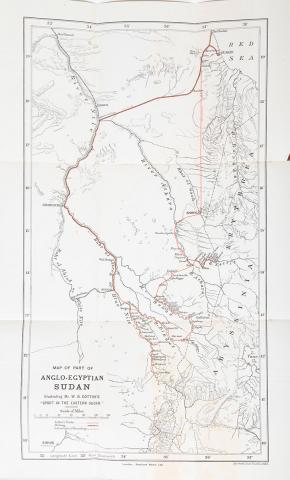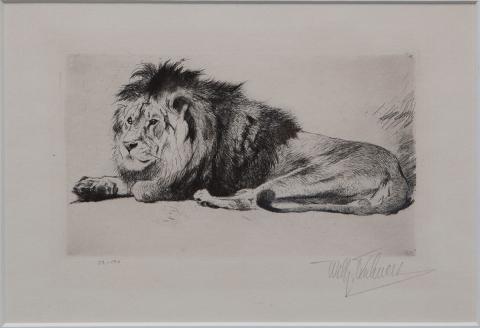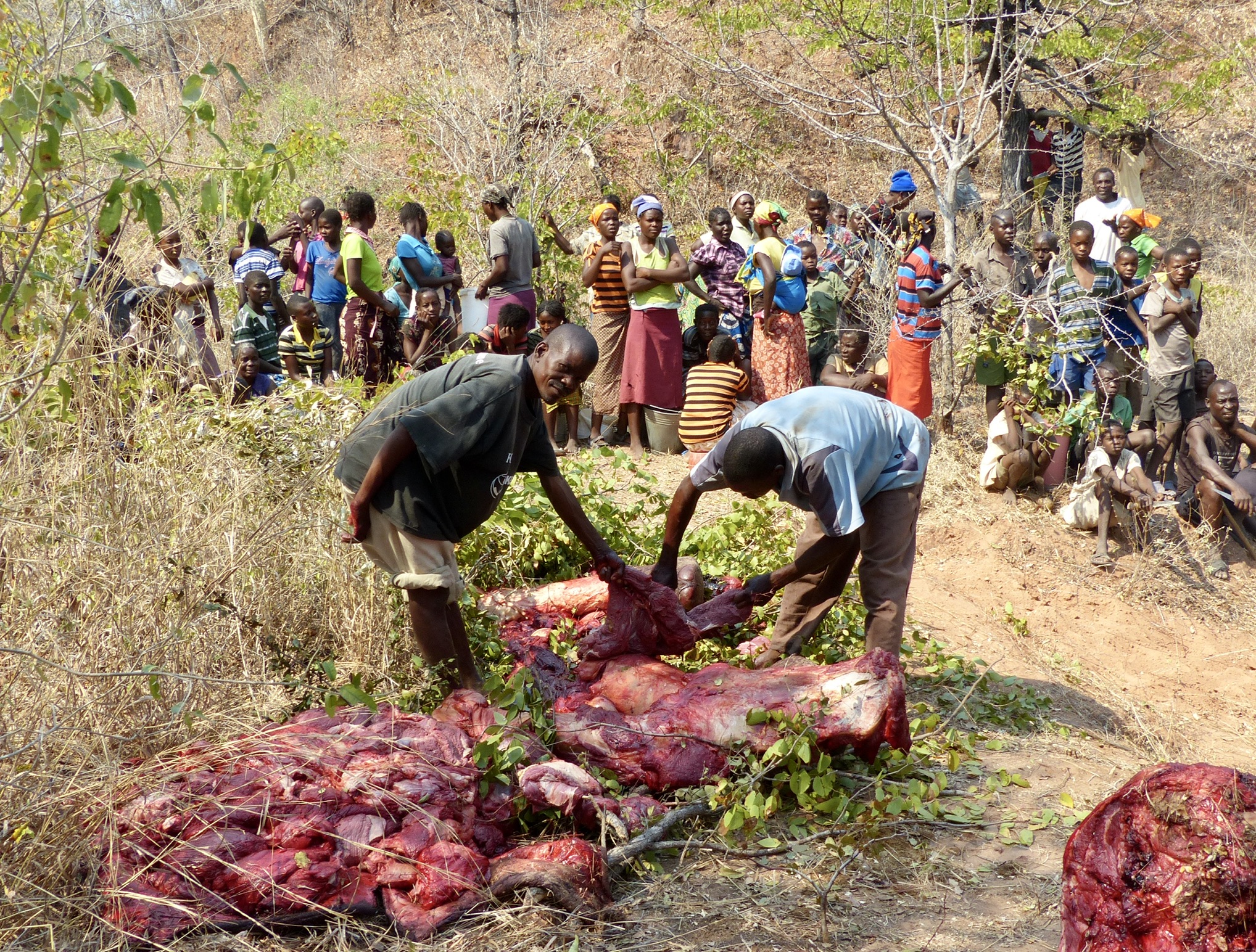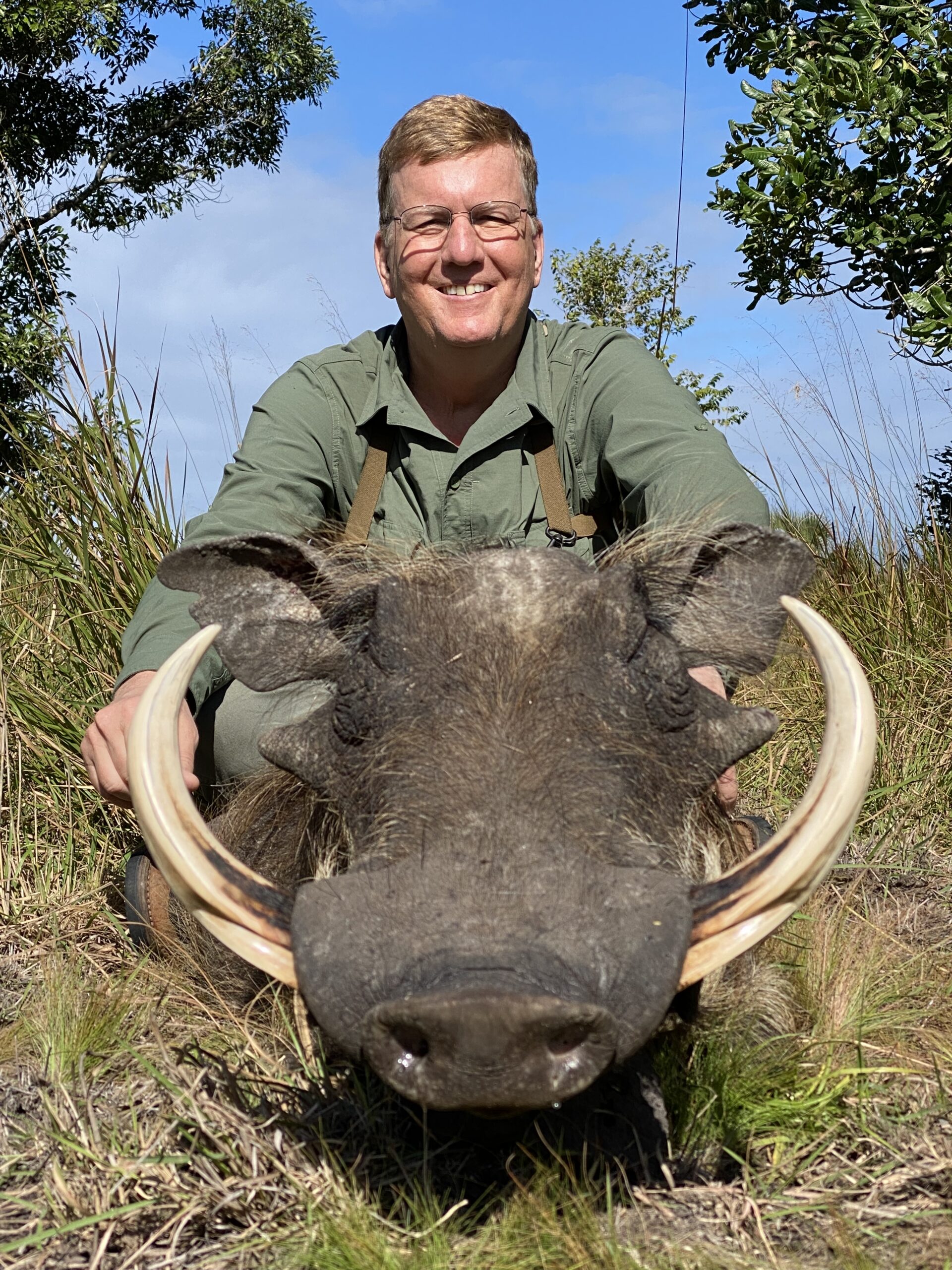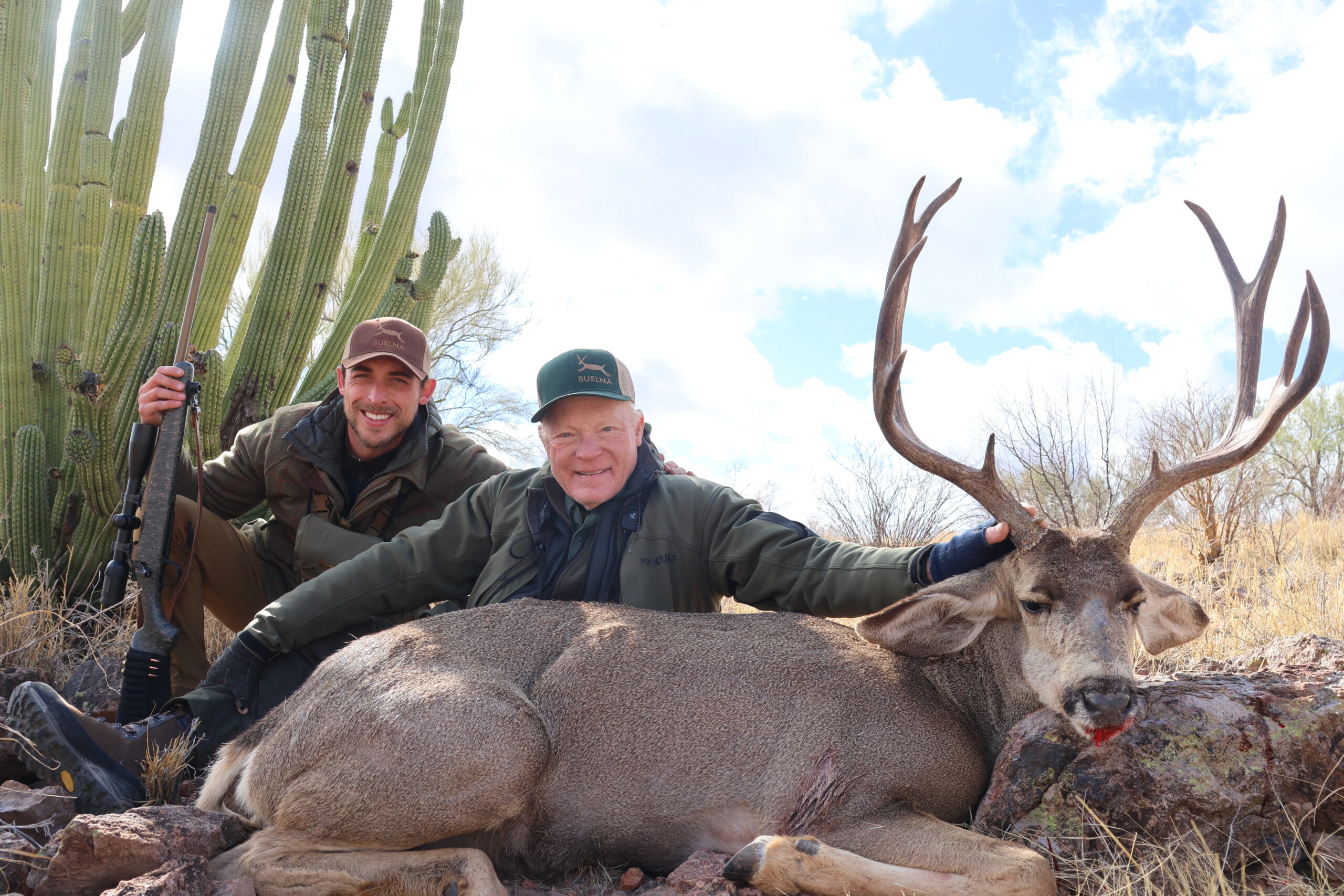While Rowland Ward is known primarily as a publisher of record books, he also published some big game hunting books. Most of them were good and today many of them are scarce. Cotton’s book about the Eastern Sudan is most interesting, especially the first edition published with a large foldout map. While many think of this area for large elephants, it also has many lions. These provided sport for Mr. Cotton.
December 29th. We marched eight miles to Wad Heleu on the Settit. We bagged some guinea fowl and saw a gazelle but had not had my rifle handy. When we came upon fresh lion tracks in the approach to the river, so we made a machan in the afternoon, intending to sit up for half an hour or so in the evening. However, the goat had hardly called for ten minutes before it stopped calling and began to stare fixedly to the right of my machan. After some ten minutes a lioness sprang, killing the goat instantly and attempted to drag it off. However, a .500 Express bullet through the shoulder stopped the operation and she lay sprawling beside the dead goat.
Another lion started calling some twenty minutes later, but as I had no electric lamp I came down from the machan. I called for my men and sent for a camel to come from camp which was only 500 yards off across the Settit. We carried off the dead lioness, leaving the dead goat in situ. We heard the lion call once more but not again.
The next morning I visited the dead goat but it was untouched and we found no lion tracks on the road for almost two miles. I did not enjoy the walk as my donkey had deposited me in the River Settit by stumbling so we returned to camp to skin and clean the lioness. I returned to the machan in the evening but the goat refused to call and to add to my troubles the electric battery turned off.
The following night I spent most of it in the machan, hoping to fix the magnesium light. At 10 p.m. the lion started calling half a mile or so downstream and worked right up to the machan, calling every twenty minutes or so, obviously seeking his mate. Finally I heard him in the grass, twenty yards off, but the goat remained silent. The lion took the wrong turn and never saw the goat at all. He continued to call upstream. His last call was at sunrise, I thought from almost a mile away.
I searched for the lion’s tracks but they were to and fro all over the place. Then I made a perch for the evening in another tree, near where I thought the lion had been last heard. I returned for breakfast at 11 a.m. and managed to get the electric lamp in order and resole a pair of boots. I spent the evening on the perch but without success. I returned to camp to learn that the lion had been calling in the patch of cover where I had shot the lioness and the machan was all-ready. I hurried to this machan after dinner but the lion had gone and was heard no more.
The next morning I felt a bit unwell so I spent a quiet morning fishing and duck shooting and then more fishing in the afternoon. The day after this, I felt better and spent the night in the lion machan. There was absolutely no moon but the stars gave some light and the lamp was working well. I went to sleep and was awakened at midnight by piercing screams from the goat. Afterwards I found that the iron chain prevented fatal grip of the neck and the poor brute was basically flayed alive. I aligned my rifle, turned on the light and saw a lion standing over the goat. As soon as he saw the light he moved off too quickly to allow a sure shot and I turned off the light again. After ten minutes the goat gave another scream. I turned on the light again and saw the lion standing over it. He moved off again but turned around which allowed me a not very satisfactory shot which I was compelled to take. Meanwhile the lion disappeared to the right growling. As the goat was now dead there was absolute silence and I turned off the light.
After a quarter of an hour, in the dim light, I saw a dark form advancing stealthily from the right. Unfortunately my rifle clinked against a chain of the machan and the lion was off at once, giving me no chance at a shot. After thirty minutes I saw another dark shape on the road and the lion again advanced stealthily. I made a great blunder trying to align my rifle before he had seized the goat. He bounded off and returned no more.
I was almost certain that I had missed cleanly except for the fact that when I was engaged with the lion stalking the dead goat, I distinctly heard a heavy body move the grass to the right of the machan. Nothing more occurred until daybreak, although I did not get much sleep. A different lion roared every now and then from beyond the settit, behind my camp. At daybreak I came down and searched for blood and found none so I whistled up the shikaris. But, just before they arrived I found blood in the direction in which the lion had retreated after the shot. Further on the men found more blood and a piece of flesh and then more specks in the direction in which I had heard the grass move.
At first I thought this might be some blood or flesh from the goat that the lion had on his paws or mouth but the trail of blood continued so far it became certain that the lion had been hit and that it was a second lion that had occupied my attention afterwards. I marked the trail and went back for the .470 cordite, the .350 cordite and also the .500 Express which I use at night, being more familiar with it than the other weapons. I gave the men the .350 and .500 and took the .470 myself, with soft-nosed cartridges and we started to track the wounded lion.
Some vultures had collected on a slightly rising ground ahead and the shikari seemed confident that the lion was dead. The quantity of blood was a good sign (though I still suspected the lion was only wounded). However, we continued to find more blood and several places where the lion had lain down, marks where it clawed the ground and finally a handful of wet foam on the ground. We were now certain that the lion was hit hard and was close.
The trail took us to a khor with steep sides and an open space at the bottom. My men were descending when my “good angel” whispered a warning that undoubtedly saved the life of at least one man. I stopped the shikaris and took up a commanding position over the khor, into which I began to throw large boulders. I had not thrown half a dozen into a suspicious clump of bushes were there was a stir and a growl not more than fifteen yards ahead of where I had stopped the trackers. I was certain that we had found the wounded lion and had just stopped walking through a tangled mass of thorns right into his mouth.
We then collected on the bluff where I had stood to throw stones. This commanded the entire open space at the bottom of the khor, where the bush in which the lion lay was practically detached. We then began to throw showers of stones into the bush as the lion would have to charge uphill, through bad thorn and could hardly escape being shot before he got home. However, the lion understood the position equally well and was determined not to move. Ultimately I was forced to send a camel-man as a marker up a sufficiently high tree and make a detour which would land us above the lion on the far side of the khor where we might get a better view.
This manoeuvre was executed satisfactorily and we finally got into position twenty yards from the bush and well above it. We had a good view except for right beneath us. We again threw more stone, the bush being only about five yards long. We must have hit the lion over and over again but he would not stir. Finally as a last resource I sent back to camp for my shotgun, and when it arrived I loaded it with buckshot. Then placing the .470 in readiness at my feet, I fired both barrels of buckshot into the bush. The response was vigorous and immediate. Long before I had time to get ready with the .470 the lion charged out of the bush across the open space into the thick thorns beneath our feet and we had the second narrow escape of the day, as there was a path behind us up which he could have advanced. I could not see to shoot until the lion was within three yards.
However the lion stood growling in the bushes five yards below us, and did not attempt to charge up the hill. And we did not lose much time in retreating to a safer position. We then saw the man in the tree signaling to us, and it became practically certain that the lion could not be seen from the bluff which we had originally occupied. We therefore made a second circuit for the original position and arrived in safety, though one of the men did his best to induce me to take a path which would again have taken us within certain charging distance of the lion. No sooner had I taken a breath and come out on the bluff, than I saw the lion detect us and stand up under a tree on the far bank of the khor, about thirty yards off.
The shot was not a nice one as the lion was partially obscured but it was obviously now or never as the lion was full of fight and we could never hope to engage on more favorable terms. So I aimed for what seemed to be the middle of his body with the .470 and pulled the trigger, knowing that probably somebody’s life depended on the shot. As it turned out, both barrels of the .470 went off simultaneously and the recoil made me stagger back with my helmet over my eyes and my glasses all awry. Fortunately the result was all that could be desired at the other end as the lion was knocked down and could be clearly seen under the trees. The shikaris said that he still had life in him so I took another shot with the handy little .350, which evoked no response. After waiting ten minutes we descended into the khor, noting how we might be walking into the lion’s mouth if he were still alive. We came to within ten yards of the lion and I saw his jaws still working so fired another shot from the .350. This left no doubt of his final demise.
We then began to admire our trophy while two shikaris began to tell alarming stories of the presents they would expect from me in the future, presents which they believed they earned. We sent for the baggage camel. On examination we noted that the shot from the machan had gone through the stomach and left entrails protruding, which explained the subsequent actions and reluctance to charge uphill. Had the lion charged uphill it would have made for a most difficult shot. The two .470 shots had also penetrated (there being no sign of exit holes on the other side. I gave my two men one pound sterling each for each of the two lions, which seemed to be the regular rate, and added a dollar for each camp servant (this was after paying them for my leopard trophies).
It is clear that Africa is not a country for a poor man. I spent the night sleep well in my bed.–Selected and Edited by Ellen Enzler-Herring of Trophy Room Books

